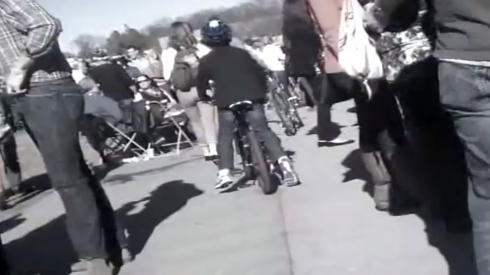Happy Monday,
Living as an urban enthusiast in Atlanta can be difficult. Apparently parks, museums, walkability, safe cycling routes, good food, fun pubs, and cultural diversity are things that most people around here seem to not enjoy. Because of this, it’s easy to get discouraged in this town. To help myself out of the doldrums, I devised a list of 5 things that make me hopeful for this city.
1) The Downtown Streetcar is Moving Forward

The City of Atlanta is installing it’s first streetcar line 64 years after the last streetcars were removed from Atlanta streets. The streetcar lines connects Centennial Park, Fairlie-Poplar, Downtown, and the Old Fourth Ward at the MLK Center.
I am hopeful that this project is a success. A successful streetcar line would lead to further expansion, more connection points to MARTA, connection to the Beltline, and eventually a true streetcar system for the City of Atlanta. Such a system would provide a level of car-free mobility that Atlanta hasn’t seen in over half of a century.
The task is tall however. Much of the area where this streetcar is to be installed is blighted, and there is heavy risk in staking this much capital in an “up-and-coming” neighborhood . If the streetcar proves unsuccessful in improving the economy and livability in the service area, especially the areas within a few blocks of the interstate, then naysayers will cite that failure as hard evidence that Atlanta is not fit for streetcars. On the other hand, if the streetcar is successful and makes a large positive economic impact on the downtown communities, then it will be impossible to deny that a streetcar network should be expanded throughout the city.
As an aside on this topic, I must admit that I’m worried about headways. First impressions are important for new systems. If people are unsatisfied with their first trip, then they may never give the system another chance. Because of this, I am worried about the reported 15 minute headway projected for this project. One streetcar every 15 minutes is not very frequent. With such a short rail line, I would more likely walk than wait 15 minutes for service. It only takes 2 streetcars to operate at 15 minute headways on this line. The City of Atlanta owns 4 street cars. In order to make a solid first impression, these streetcars should operate at no more than 10 minute headways. If ridership is low, then headways can be increased.
2) Marta Releases Real-Time Data

Back in October, MARTA released its real-time bus data and the GTFS schedule data for its buses and trains. Since then, the real-time bus feed has been continually refined and improved by the hard-working people at MARTA in order to give consistent and accurate updates about bus locations. I know of several 3rd party developer teams who are working to release apps that take advantage of this data.
In the coming weeks, I hope to see good apps hitting the market. Real-time bus data will have a dramatic effect on the practicality of MARTA. We all know that many of MARTA’s routes suffer from very long headways. Some buses operate at 40-60 minute headways, even during peak weekday hours. In addition to the long headways, the buses are often late or early depending on the notoriously unpredictable Atlanta traffic.
It is very stressful to be waiting at a bus stop, with no shelter, no sidewalk, on the side of a 7 lane highway, in July heat or February freeze and wondering if the bus is ever going to show up. Is the bus 10 minutes late or did it come early? Well, real-time data can’t fix all these problems, but at least you would know where the bus is and when it is coming. Then you don’t have to wait at one of our city’s lovely dignity-free MARTA stops while being stared at by every driver passing you by. You can walk out to the stop moments before your bus arrives and forget all the extra stress and associated nonsense. If the bus is going to be 10 minutes late, I would rather spend that time inside the Starbucks.
3) Cycling Infrastructure is Improving

Atlanta is getting some good momentum on the bicycle infrastructure front. There seems to be a consensus among advocates and city politicians and planners that Atlanta needs to seriously embrace bicycling as a legitimate mode of transportation. This is evidenced by current and upcoming bicycle projects that will connect important and practical locations around town.
For instance,
- Ponce de Leon is getting separated bicycle infrastructure this summer. This will allow bikers to easily travel from Peachtree St. and the North Ave MARTA Station to the Beltline, Ponce Market, and the Whole Foods shopping center.
- 10th Street is also getting separated infrastructure to safely move bikers between Midtown and the Beltline.
- Juniper Street is getting a total overhaul. The overhaul will lead to fully separated bike paths, intersection improvements, and vastly improved sidewalks. It will be a great walkable complement to Peachtree Street one block to the west, and it will also serve as a much needed southbound bike route through midtown. I don’t have a link to the project page, but the image above is from an open house held earlier this month describing the project.
- In addition to these projects, a host of other projects that extend far beyond midtown, and totaling $2.5 Million, are described on the Atlanta Bicycle Coalition website.
4) Start-Up Culture in Atlanta is Gaining Ground

The Atlantic: A Visual Guide to Atlanta’s Startup Scene
OK, this is the one entry of the five that is not transportation related. Efficient transportation and a vibrant urban setting are impossible and useless without a strong economy and jobs for Atlantans. I would love to see a strong start-up culture here. Atlanta has a lot going for it in this area. We have great universities (e.g., Georgia Tech, Georgia State, Emory, the schools at the Atlanta University Center). Atlanta is affordable. It is much more affordable to live an urban lifestyle in Atlanta versus other similar cities. We have a ridiculous airport that makes Atlanta a great place to base a national or international company; it’s easy to get anywhere from here. And, we are also home to more than our fair share of Fortune 500 companies.
Atlanta seems to have the necessary pieces for a strong start-up scene and that is being recognized around the region and country. More start-ups were funded in Atlanta last year than any other southern city. (We don’t count Texas because they aren’t real southerners.) With the ongoing success of ATDC, FlashPoint, Atlanta Tech Village, Hypepotamus, and countless other start-up accelerators and services, I expect Atlanta’s tech start-up scene to start making more and more noise nationally and internationally.
5) BeltLine Popularity is Out of Control
Nobody goes to the BeltLine anymore. It’s too crowded.

The popularity of the East Side Trail shows just how much latent demand there is for walkable places in this city. So much so that some people are beginning to fight over the limited pavement space on the EST, for instance, the guy discussed in this article in Curbed. Overcrowding is a problem. But it’s a good problem to have and much better than the alternative. It’s oddly refreshing to hear people griping about Atlanta traffic that does not involve cars. It’s actually kind of mind-blowing.
This popularity of this section of the BeltLine has led to the stores and restaurants adjacent to the BeltLine to transform what used to be their rear entrances, parking lots, and dumpster sites into welcoming patios and front entrances to accommodate this new source of customers. What used to be vacant industrial sites around the East Side Trail are now prime real estate for Atlanta’s latest awesome amenity.
The popularity of the BeltLine and the reaction of the adjacent businesses gives me hope that more similar developments will also be well received. The East Side Trail is just a small start for building a thorough network of practical cycling and walking paths in Atlanta. I hope that this section of the BeltLine will eventually have transit connecting it to the downtown streetcar and potential midtown streetcars in the future. Can you imagine having a streetcar circuit that connected the East Side Trail, the downtown streetcar, 10th street, 14th street and the West Midtown area on Howell Mill? That relatively small circle would be a fantastic streetcar network for midtown and downtown Atlanta. I might be dreaming a bit, but it’s fun to imaging having that type of car-free connectivity in Atlanta.
In other news…
- Rebecca Serna of the Atlanta Bicycle Coalitions responds to Melissa Carter‘s ill-informed anti-cyclist diatribe.
- Apparently car rental taxes are being considered to fund transit in Atlanta. I’m not sure where I stand on this issue, but I do know that it’s absurd that the current rental car tax is used to pay for the Philips Arena. What in the hell does me renting a car to drive out of town have to do with the Atlanta Hawks?
- Some new high rises are suggested for Midtown. Whoopeedeedoo!
Tags: atlanta, Beltline, Bicycle, east side trail, GTFS, MARTA, streetcar




















